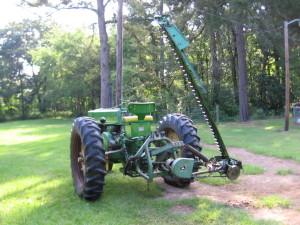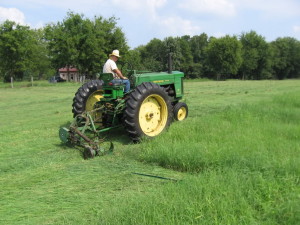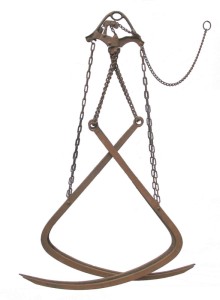If you’ve ever been around fresh cut hay, who could ever forget that great smell? During haying time, I remember doing different jobs on the farm, depending on how old I was at the time. Especially one job with my great uncle, Tommy Glennon.
Before anything was done, you had to watch the hay field closely to determine when the alfalfa and red clover was ripe. And always keep an eye on the weather forecast. It wouldn’t do to cut hay only to have it rained on for several days. One could handle an occasional shower on a fresh cut field, but a three day soaker would make your hay much less valuable as a feed source for the cattle.
I got to do each of the farmyard jobs at one time or another, depending on my age. I remember the first job was driving the little Ferguson tractor to pull the hay rope and bales up and into the hay mow. All I had to do was drive slowly in a straight line. When the trip rope was pulled, I had to back up in a straight line being careful not to drive over the thick hay rope before it was pulled out of the barn for the next eight bales. In subsequent years I got to mow and rake hay in the field. And eventually I was the one to climb up the loaded wagon, stick the forks, pull the trip rope, pull the carrier and forks back out of the barn, also with the trip rope, and do it all over again. All the while smelling that sweet smell of fresh cut hay!
As I grew older, I got the job of mowing the hay field so the clover would start drying. The mower was a moving sickle blade pulled behind the tractor, with the sickle held upright while moving the mower to the field. Once in position, the sickle had to be lowered from vertical to horizo ntal to cut the hay at ground level. Dad constantly reminded me of the danger of loosing my fingers while doing this part of the job. The bracket holding the sickle upright was removed, then the sickle was lowered by hand. As it was lowered, stationary guards and the razor sharp sickle would move apart in relation to each other. The guards provided a nice place to hold onto while lowering the sickle, but also was the worst place because the relative movement of the two pieces would cut your fingers off. So I was always reminded of the proper way to accomplish this dangerous task.
ntal to cut the hay at ground level. Dad constantly reminded me of the danger of loosing my fingers while doing this part of the job. The bracket holding the sickle upright was removed, then the sickle was lowered by hand. As it was lowered, stationary guards and the razor sharp sickle would move apart in relation to each other. The guards provided a nice place to hold onto while lowering the sickle, but also was the worst place because the relative movement of the two pieces would cut your fingers off. So I was always reminded of the proper way to accomplish this dangerous task.
Finally, I could start mowing, simply going around and around the field in a clockwise direction. The sickle stuck out to the right side, so the tractor was in a different row than the cutting sickle bar. This meant the outer most round next to the fence had to be cut by going counterclockwise, usually after a couple of regular clockwise rounds were finished. Then the rest of the field was mowed in the normal clockwise direction.  If the hay was extra thick, usually the case in the summer’s first crop, or if I was a little too fast on the tractor, there would occasionally be a wad of hay that would plug up part of the cutting sickle and cause a streak of uncut hay. The easiest solution was to stop, raise the sickle slightly, then backup a couple of feet. This would usually wipe the plug of hay out enough so I could continue forward again. On an extra stubborn plug, I would have to stop the power take-off, which would stop the sickle movement, then pull the hay out by hand.
If the hay was extra thick, usually the case in the summer’s first crop, or if I was a little too fast on the tractor, there would occasionally be a wad of hay that would plug up part of the cutting sickle and cause a streak of uncut hay. The easiest solution was to stop, raise the sickle slightly, then backup a couple of feet. This would usually wipe the plug of hay out enough so I could continue forward again. On an extra stubborn plug, I would have to stop the power take-off, which would stop the sickle movement, then pull the hay out by hand.
Haying season was the perfect time to get that sun tan I always wanted. I would often see the railroad crews working on the tracks that ran through our farm. They always worked without their shirts on and had a dark brown leathery skin as a result. I would remove my shirt while mowing, hoping for the same dark tan to appear the next day. Of course, I wouldn’t put my shirt back on until I started to feel the sunburn on my back, and then it was too late. That night I was in pain. I don’t remember what we used for sunburn lotion at the time. It was a cream of some sort that felt cool at first, but was no match for too long in the sun. The next couple of days were painful and ended up with large pieces of skin peeling off. This was long before sunscreen and the dangers of over exposure to the sun were known. I know that these sun tan attempts contributed a lot to my skin cancers in later years. I’ll bet most of the railroad crew had it too.
Today, cutting hay includes mowing and crimping in one pass so the moist green hay will dry quicker. But in my day, each part of the process had its own step. After cutting we would wait a day or two until the moisture dried out, then rake the flat windrows of cut hay so they were turned over, exposing the underside to the sun. This would also fluff up the hay so the baler would be able to pick it up properly. Second and third crop hay is much thinner, so two or three windrows would be raked together to produce a suitable amount of hay for the baler. We had a side rake on our farm. Front and rear steel wheels were offset from each other so that moving arms could sweep the partially dried hay across and into another windrow of hay. There was an unused steel seat near the front. If it sounds like it went back to the horse and buggy days, that’s because it did. The steel seat was used for the operator when the side rake was actually pulled by a horse.
We had a side rake on our farm. Front and rear steel wheels were offset from each other so that moving arms could sweep the partially dried hay across and into another windrow of hay. There was an unused steel seat near the front. If it sounds like it went back to the horse and buggy days, that’s because it did. The steel seat was used for the operator when the side rake was actually pulled by a horse.
Finally came the baler. Dad, and many farmers, didn’t own a baler so he hired a neighbor to do the baling. Most summers it was Floyd Frederick who baled our hay. His tractor pulled the baler, a noisy machine with a rhythmic sound you could hear across the field as the baler pulled the raked hay into itself, compacting the hay with a giant plunger, and spitting it out the back end, complete with two twine strings wrapped tightly around the rectangular bale of hay. Bales weighed about forty to fifty pounds. A flat rack, or hay wagon, was attached behind the baler. One of the young teenage neighbor boys would stand on the hayrack and take the bales as they came out of the baler. They used a bale hook to help spear the hay bale with one hand while lifting the twine string with the other hand to move the bale to the rear of the hayrack. The bales were stacked across the wagon and four bales high, as I recall. As the wagon filled up, there was less and less room to stand, until there was none. Then this wagon was taken into the farm yard by another tractor that had just brought an empty hayrack to the field. And the process repeated itself. I think the hardest job was that of stacking the bales on the wagon. I remember many times it was my older cousin Tom that had this job. They were always the strongest young men around.
As the wagon filled up, there was less and less room to stand, until there was none. Then this wagon was taken into the farm yard by another tractor that had just brought an empty hayrack to the field. And the process repeated itself. I think the hardest job was that of stacking the bales on the wagon. I remember many times it was my older cousin Tom that had this job. They were always the strongest young men around.
Once the loaded hayrack got back to the farmyard it was positioned at the end of the barn, under the large open hay door. A heavy track, like one rail of a railroad, stuck out of the open door just under the peak of the roof. On this track was a combination of pulleys and steel wheels called a carrier. A large manila hay rope, perhaps an inch in diameter, ran through the pulleys and down to a side door at ground level through a series of other pulleys. This end of the rope was connected to a small tractor. At the other end, near the carrier, a set of four large tines, or forks, were attached to the rope.  The carrier let the forks down to the top of the loaded hay bales. The forks were positioned and stuck one by one into a set of eight bales. When the signal was given, the tractor at the other end of the rope drove away, pulling the forks with their eight bale payload up. When it reached the carrier on the rail, a mechanism allowed the forks to accompany the carrier along the track into the barn’s hay mow. The person that stuck the forks into the bales had since climbed down the wagon load of bales and was now manning a smaller, half inch “trip” rope. The trip rope was attached to a release on the forks. When the bales traveled down the track to the right spot, the trip rope was pulled, releasing the bales. Knowing when to pull the trip rope and approximately where the bales were in the mow was a matter of experience. You could vary where the hay bales were piled by when you pulled the trip rope.
The carrier let the forks down to the top of the loaded hay bales. The forks were positioned and stuck one by one into a set of eight bales. When the signal was given, the tractor at the other end of the rope drove away, pulling the forks with their eight bale payload up. When it reached the carrier on the rail, a mechanism allowed the forks to accompany the carrier along the track into the barn’s hay mow. The person that stuck the forks into the bales had since climbed down the wagon load of bales and was now manning a smaller, half inch “trip” rope. The trip rope was attached to a release on the forks. When the bales traveled down the track to the right spot, the trip rope was pulled, releasing the bales. Knowing when to pull the trip rope and approximately where the bales were in the mow was a matter of experience. You could vary where the hay bales were piled by when you pulled the trip rope.
One of the benefits of a hard day of baling hay in the sun, was the noon meal. This happened whether it was baling hay or filling silo, another job contracted to the neighbor that had a corn chopper. In the really old days, it would have been at thrashing time. Mom would prepare a big meal for all the workers. She would have some help from my grandmother, or perhaps some other relatives for this big event.There were extra places set at the kitchen table. It was a big deal. All the workers came in from the field and washed up in the washroom. Then a huge meal of roast beef, mashed potatoes, gravy and corn was served. Of course there was pie for desert. I remember everything being steaming hot. I watched the grownups drinking hot coffee and wondered why they did this when it was such a hot day. After the meal, the workers would sit around on the lawn under the big shade tree and take it easy for a few minutes before going back to the afternoon’s work.
I remember the day the hay rope broke. That put a stop to everything. It was a rare occurrence, but once in a while, it happens. You have to make hay when the sun shines, so getting the hay rope fixed was the top priority. Replacing a rope of that size and length was too costly and would require a lot of work to rethread the rope. You couldn’t just tie a knot in it because the rope had to fit through the pulleys. The only reasonable solution was to splice it so it would fit the pulleys and still be strong enough to raise a load of heavy bales.
This is where old time experience came in handy. There weren’t many around that knew how to accomplish such an antiquated task as splicing a rope, even in the 1960’s. I remember my great uncle Tommy Glennon, who seemed to be awfully old to me and seemed to have had a lot of experiences. He was the go-to guy for this project. I don’t remember if Tommy was already at our farm, or if someone went to get him, but it was a big deal to get him on this job as soon as possible.
The rope was pulled out to a place just outside the last pulley at ground level. A convenient spot to work on it. I watched closely as Tommy worked the frayed ends of manila. Unraveling the strands in a particular order, then wrapping them together, intertwined with each other to form a single rope again. Keep in mind that the rope also had to be spliced so that it would still support the weight it would be subjected to. And even more importantly, the splice had to be the same size as the original rope so it would fit through the pulleys. No small task. But Tommy was a pro and soon finished, even with my questions while peering over his shoulder. I remember his secret after finishing the splice: Get some water to make a small mud puddle. Roll the splice in the mud with your hands (this is the part I liked). Tommy told me this helped shrink the rope and pull it tight. As a young five or six year old, I felt like I had played an important part in getting the hay put up that summer.
Depending on how much hay there was, the entire job was finished by late afternoon. Everyone had chores to do at their own farms. As the sun set and cooler air settled over the yard, you could smell the fresh cut alfalfa and clover as you drifted off to sleep after a hard day’s work.
Nice memories. I know we always looked forward to haying time as kids. It was closer to horse and buggy days than we knew. Did Tommy learn that from Kit Carson?!!